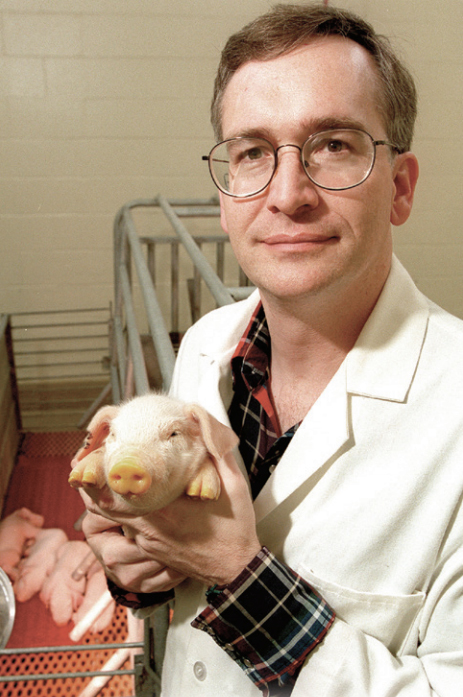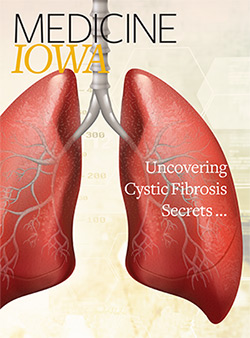“It’s a pig!”
That was the birth announcement Michael Welsh, MD, emailed colleagues Feb. 27, 2008, marking the successful conclusion of a five-year mission to produce a unique animal model of cystic fibrosis (CF) and open a new chapter in CF research at the University of Iowa.
 Using pigs instead of mice
Using pigs instead of mice
Mice are the ubiquitous animal model system for medical research, but mice with CF don’t get lung disease. It’s a mystery that has vexed researchers and hampered progress in the three decades since the cystic fibrosis transmembrane conductance regulator (CFTR) gene was discovered.
University of Iowa researchers developed a pig model of cystic fibrosis in 2008 in collaboration with Randy Prather (pictured) and his team at the University of Missouri College of Agriculture, Food and Natural Resources. That development would move researchers closer to a more complete understanding of CF and its effects on the whole body in a way that novel cell models and other animal models could not.
Unlike mice, the CF pigs are affected by loss of CFTR function in ways that closely mimic humans with CF. Newborn CF piglets develop meconium ileus, a bowel obstruction, which often is the first sign of CF disease in humans. CF pigs also have an abnormal pancreas, liver, and gallbladder. And, although the pigs’ lungs appear normal at birth, infection and inflammation develop early.
“We didn’t know exactly what we were going to find in terms of exploring this model, but we knew it gave us an enormous opportunity to understand what’s wrong, and an opportunity to impact people with CF in a way that we hadn’t been able to before,” says Welsh, co-founder of Exemplar Genetics, an Iowa business working to generate new animal models of human diseases.
A close-up look at the CF disease process from birth helped the UI team quickly resolve the longstanding “chicken and egg” conundrum of infection and inflammation. In CF pigs, infection occurred first, revealing that from birth, CF lungs are impaired in their ability to kill and clear bacteria. The finding supported the clinical practice of treating lung infections in children early and aggressively.
“Knowing that infection is first suggests that if we can prevent or fight infection, that might delay or prevent the lung disease in people with CF.”
David Stoltz, MD, PhD
New models to test therapies
By revealing new and unexpected mechanisms of disease in CF, a novel animal model can uncover new potential targets for therapy. At the same time, the models also provide a unique opportunity to test these new therapies.
Besides the pig model, UI researchers created a ferret model in 2010, under the leadership of John Engelhardt, PhD, professor and head of anatomy and cell biology and director of the UI Center for Gene Therapy. The CF ferret is providing insight into CF-related diabetes, a less well-known but serious complication of the disease caused by CF’s effect on the pancreas.
The pig model has been key to determining the impact of acidity in CF lung disease. The thin layer of liquid covering the airway surface is more acidic in CF lungs. This impairs airway killing of bacteria and other inhaled pathogens and alters mucociliary clearance. These disruptions make CF lungs particularly susceptible to airway infection, a major cause of disease and death in CF.
“We’re developing new strategies to make this liquid less acidic, and we’re already beginning to move some of these trials into the clinic to find out whether or not they’re effective in people with CF,” Stoltz says.
Not only has the pig model enabled discoveries that appear to be clinically relevant for people with CF, it also helped UI scientists answer that longstanding question of why CF mice don’t get lung disease. While the airway surface liquid is more acidic in pigs and people with CF compared to their unaffected counterparts—leading to impaired host defenses—no such difference exists between CF and non-CF mice.
By Jennifer Brown
View other features on cystic fibrosis research

Featured in Medicine Iowa Spring 2018
You're reading one of the features included in the Spring 2018 issue of Medicine Iowa. Read more news and features about the people and programs focused on teaching, healing, and research in the UI Roy J. and Lucille A. Carver College of Medicine.